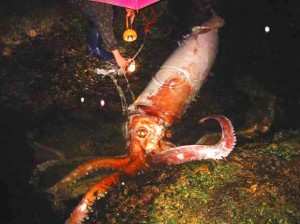A hunt under way in a swath of North Pacific waters has dramatic echoes of Moby-Dick, 20,000 Leagues Under the Sea, and, for that matter, The Abyss—especially since the spheroid cockpits of the minisubs being deployed look a lot like those featured in James Cameron’s sci-fi movie.
In this month’s iteration of close encounters with sea creatures of the large kind, a group of researchers is plotting to shoot and capture a giant squid—on film. For all the many miles of footage documenting creatures large and small, there is virtually none of the giant squid, formally known as Architeuthis dux—a suitably grand and awe-inspiring binomial that sounds as much like a mythical monster as a proper name from zoological nomenclature.
In 2002 off a beach in Japan, researchers took the first-ever photograph of a live adult giant squid. (Copyright (c) Kyoto Prefecture)

Architeuthis dux has mostly been seen dead or dying after washing up on shore, or when inadvertently caught up in commercial fishing nets. It has almost never been witnessed swimming freely, feeding, or otherwise going about its cephalopodic business in its natural environment. Consequently, far more is known about the behavior of a creature like, say, Kim Kardashian, than about the world’s largest invertebrate. Females can grow to be about 45 feet long and weigh 600 pounds, while males reach about half that size.
But apart from such vital statistics, the squid hunters know nothing, for example, about how the squid themselves do their hunting. Are they patient predators who drift with the currents, conserving energy until they encounter a food source, as many other deep-sea denizens do? Or do they actively seek out their prey? Does the manner of attack vary with the size of the prey? Do they vertically migrate, approaching the surface by night and dropping into the dark depths by day? The climactic end of The Abyss is not all that far-fetched in its implication: you never know what you’ll find in the ocean’s depths.
One reason for all the unanswered questions about Architeuthis is that it favors depths from about 400 feet to more than a half-mile, well beyond the reach of typical scuba divers. So a team formed by the Japan Agency for Marine-Earth Science and Technology, known as JAMSTEC, the Discovery Channel, and the Japanese public broadcaster NHK has enlisted a 185-foot private motor yacht, the Alucia, and headed out to waters 550 miles south of Tokyo, around the Ogasawara Islands, that are believed to be frequented by giant squid. The boat carries three submersibles, the deepest-diving one being the American-made Triton 3300/3, which can take a pilot and two passengers to depths of 3,300 feet, well into squid territory.
The three-person crew gets a wide range of vision from inside the spherical acrylic cockpit, although during daylong shifts those seated side-by-side in the sub often drift in total darkness. The pilots are using the sub’s bright headlights sparingly so as not to scare away the squid. They find their way using sonar and by peering through the high-definition cameras designed to shoot in low light.
Scientists are trying out a combination of methods to attract squid, including baited long lines hanging from the surface, injections of pheromones into the water, and optical lures that mimic certain bioluminescent displays, a favorite tactic of Edith Widder, CEO and senior scientist at the Florida-based Ocean Research & Conservation Association. Still, there is a lot of water to cover.
“It is indeed a vast ocean and there is no question that a project such as this is a long shot,” says Widder, who is at sea this month as part of the research team assembled by NHK and the Discovery Channel. “However, this is the most time, money, and scientific expertise ever invested in such an effort, so I think we have a better chance than any previous mission.”
Tsunemi Kubodera of Japan’s National Museum of Nature and Science, another researcher on board, led the team responsible for the only pictures ever taken of a giant squid in the wild. That was in 2004, in the same waters, but using a method that sounds more Melville era than post-millennial: A downward-facing camera, with bait just below it, was dangled on a line more than a thousand feet long. On a September morning, after three seasons and a couple of dozen attempts, a giant squid finally took the bait, and the automated camera took the pictures—one about every 30 seconds.
It’s not entirely a Jules Verne fantasy to imagine that an eight-armed giant squid might be inclined to give a submersible a bear hug—and by its sheer weight drag the little craft down into the abyss, below its crush depth. But, says Widder, “That’s not a possibility that keeps me awake at night.”




